A History of Seattle Radio Station KOL
By John F. Schneider W9FGH © 2023
|
|
A History of Seattle Radio Station KOL By John F. Schneider W9FGH © 2023 |
|
www.theradiohistorian.org Copyright 2023 - John F. Schneider & Associates, LLC (Click on photos to enlarge)
A KFOA program schedule from 1928
Don Isham, KOL's music director, plays the Kimball 3 manual 12 rank theater organ in KOL’s Northern Life Tower studios.
The entertainers on the daily noontime "KOL Carnival" Merrill Mael on the
air with Amy Bowden 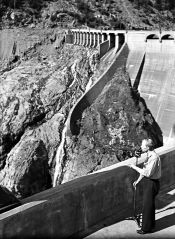 KOL announcer Wheeler Smith was at the top of the Diablo Dam on the Skagit River, and Frank Anderson was 310 feet below at the bottom of the spillway. Each held a microphone so that listeners could hear the roar of the water flowing over the spillway. (City Light photo) 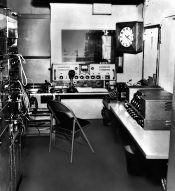 This undated view of the KOL control room is most likely from the late 1940's or early 50's.  Some KOL voices from the 1950's  A 1961 KOL music survey, showing the photos of the station's deejays 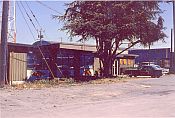 This was the KOL building and tower on Harbor Island in the 1960's 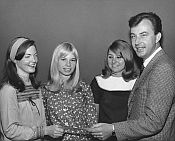 KOL program director Dick Curtis (later station manager) with a group of contest winners at the Windjammer Restaurant in 1967. (Dick Curtis photo) 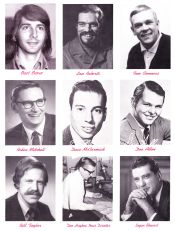 Some of KOL's popular deejays of the 1960's 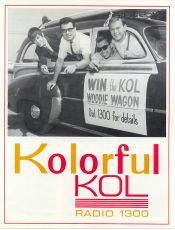 In 1965, to kick off the new Top 40 format, KOL disk jockeys toured every high school in the area, giving away about 10,000 free records. They traveled in the KOL "Woodie Wagon", complete with surfboard. Here are Tommy Vance, Don January, Rhett Hamilton Walker, and Danny Holiday. 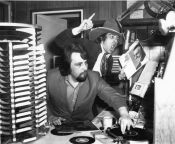 On April 1, 1970, as an April Fool’s joke, Top 40 KOL and Country KAYO swapped their drive time disc jockeys for a day.
|
|
A New Station Takes to the Airwaves In 1922, C.B. Williams, the manager of Seattle’s Rhodes Department Store, read with great interest about radio broadcasting in the East. He decided that “What’s good for easterners is just as good for the people of Seattle and the Pacific Northwest.” And so it was that the Rhodes Brothers Department Store put station KDZE on the air May 17, 1922. The KDZE call sign was sequentially issued by the Department of Commerce. KDZE’s studio was located on the second floor of the department store in the Arcade Building, at 1325 Second Ave.,where shoppers could stop and watch the radio broadcasts as they happened. The transmitter itself was enclosed in a 12-foot square glass case for public viewing. Rhodes shoppers could also browse the store’s radio department, where they could buy parts to build their own receivers, as well as complete finished sets. KDZE initially used a 50-watt transmitter built by Louis Wasmer, the operator of a Seattle motorcycle shop who had a hand in birthing many of the Northwest’s early stations. The antenna was suspended from two masts atop the department store’s building. Wasmer supervised the installation of the station. The station’s first manager/operator was Carl E. Haymond, who had been the chief operator of the Post-Intelligencer station KFC, Seattle’s second radio station. He joined the Rhodes station after KFC ceased operations. The first KDZE programs consisted mainly of recorded music played from a wind-up phonograph and talks about fashions and wearing apparel. At that time there was only one frequency authorized for broadcasting – 360 meters (833 kHz). All stations were required to share time on this single channel. When it first opened, KDZE was one of eight stations that shared time on the single broadcasting frequency -- it operated 3:15 to 4:00 PM daily except Sunday, and also 7:15 to 8:15 PM Monday, Wednesday and Friday nights. Expanded Operations In 1923, the Department of Commerce expanded broadcasting beyond a single frequency, establishing the beginnings of the AM broadcast band. This allowed KDZE to move to its own frequency of 1110 kHz, where it operated with 100 watts and increased operating hours. On March 10, 1924, the call sign was changed to KFOA. In 1924, the Rhodes store expanded into the Arcade Building’s enlarged north side, facing Union Street between First and Second Avenues. KFOA moved into larger quarters on the fourth floor of the building, and installed a new 500-watt transmitter, built by Kilbourne-Clark Company, an established Seattle manufacturer of radio equipment. Two 120-foot tall self-supporting towers on the roof supported the station’s big new wire antenna. In raising its power to 500 watts, KFOA became Seattle's only Class "B" station, which was the highest class of license issued by the government. (Class "B" stations were required to operate with at least 500 watts of power, and all programs had to be live. Soon after, KJR and KTW also became Class "B" stations.) This allowed it to move down the dial to 660 kHz, a more favorable frequency. In March, 1925, KFOA’s power was raised once again to 1,000 watts, considered very high power for its time. KFOA’s programs at that time featured live music during many of its broadcast hours. The Hoffman Concert Orchestra performed several times daily, and the Eddie Harkness Dance Orchestra was picked up remotely from the Olympic Hotel in the evenings. The Seattle Saxophone Band was a 14-piece all-sax band that played only classical music. In 1925, An affiliation with the Seattle Times was arranged, and several special programs were produced by the Times staff. On May 27, the Times produced a program organized by the Seattle Women’s Club, featuring old-time songs and a lecture about Seattle’s pioneer days. This was followed the same night by another Times program featuring Scandinavian dance music. Remote broadcasts from outside the studio were frequently heard, including the luncheon speeches of the Rotary, Kiwanis and Lions Clubs. In 1924, KFOA broadcast the Knights-Templar national convention parade, which passed directly in front of the Rhodes building. Carl Haymond broadcast a live description of the parade with pickups of the band music from the roof of the store. On May 29, 1925, a gala remote broadcast celebrated the opening of the Monte Cristo Hotel in Everett. In 1926, Haymond left KFOA when he purchased station KMO in Tacoma. Rhodes Manager C.B. Williams then became the director of the station. Haymond operated KMO until 1954, and also built one of the area’s first TV stations, KMO-TV. Meanwhile, Louis Wasmer had been operating his own Seattle station, KHQ. In 1925, he packed KHQ’s equipment into the sidecar of his motorcycle and moved the entire station to Spokane. He went on to become Spokane’s most influential broadcaster, operating stations KHQ and KGA. In those years before established national radio networks existed, periodic temporary hookups would be arranged connecting stations around the country to broadcast single special events, such as presidential speeches, and KFOA participated in many of those. Then in 1927, KFOA became the Seattle affiliate of the newly-formed National Broadcasting Company (NBC) Pacific Coast Network, carrying the network's first live programs from San Francisco. In 1927, the newly-formed Federal Radio Commission began changing the frequencies of many radio stations to address the problems of extreme interference that existed in many parts of the country. This resulted in a move of KFOA from 660 to 670 kHz. The following year, the FRC instituted a complete reorganization of the AM broadcast band. As a part of this change (FRC General Order No. 40), KFOA was moved up the band to 1270 kHz – a less desirable frequency – and made to share time on the channel with another Seattle station, KTW. (This time-sharing arrangement continued until 1931, when KTW moved to 1220 kHz, freeing the 1270 channel for full-time operation.) KFOA Becomes KOL By 1928, the Rhodes store was reportedly running short of cash, and this perhaps led them to sell KFOA. In any event, that is when Louis Wasmer again entered the picture. He teamed up with his brother-in-law, Archie G. Taft, Sr., to buy the station. Taft was the owner of Piper and Taft Sporting Goods, and had gained an interest in radio by selling crystal sets from his store. Together they formed the Seattle Broadcasting Company, purchased KFOA, changed the call sign to KOL. Taft became the president and general manager. Not long afterwards, they moved the studios to the ground floor of The Northern Life Tower, an iconic new art deco building at the corner of Third and University in downtown Seattle. On April 9, 1930, a broadcast of bandleader Paul Whiteman’s CBS program celebrated the opening of the new KOL studios. In the Northern Life Tower, KOL had a single large studio, plus a small announce booth and a control room. In 1931, the Seattle organ manufacturer Balcom and Vaughan installed a Kimball 3-manual 12-rank theater pipe organ in the KOL studio. This was the time when “talking” motion pictures had taken over field, and many theaters were disposing of the massive pipe organs that had been important to them during the silent film era. Radio was coming into its own at that time, and so many of these second-hand instruments ended up at broadcasting stations. In the case of the KOL organ, a composite instrument was assembled, consisting of a Kimball from the Grand Theatre and a Wurlitzer from the Colonial Theatre, all controlled by a Wurlitzer console modified by Balcom to 3 manuals. Don Isham, KOL's music director, performed on the organ as a daily program feature. In 1930, in a West Coast network realignment, NBC moved its Seattle affiliation from KOL to KOMO, and KOL then joined the new Columbia-Don Lee Network, which had been formed to relay the New York-based programs of CBS on the Pacific Coast. The CBS programs were divided between KOL in Seattle and KVI in Tacoma, with KVI broadcasting the daytime programs, and KOL airing the network’s 5:00 to 9:00 PM schedule (KVI did not broadcast in the evenings at that time). When the CBS programs ended at 9:00 PM (midnight, eastern time), the Pacific Coast network distributed programs originating from the Don Lee stations KHJ and KFRC in California. In addition to its many network programs, KOL broadcast a number of its own programs which were popular with Seattle-area listeners. These included “Matinee Manor”, and “Pioneers”, and the “KOL Carnival”. The latter was a daily variety program featuring live music and comedy skits. – a style of radio program that was increasingly popular at the time. Among the many radio voices that graced the KOL microphones was announcer Wendell Niles, who was heard daily on KOL from 1930 to 1935, before he moved on to NBC in Hollywood and became one of network radio and TV’s great announcers. He was replaced at KOL by Art Gilmore, who had just finished schooling at Washington State University. For his part, Gilmore moved on the following year to KFWB in Los Angeles, and then to the CBS flagship KNX. After a tour of duty in World War II, his distinctive voice was regularly heard on network radio and TV. He also narrated a major portion of the 1950’s and 60’s film trailers. Another KOL discovery was Howard Duff, a 1932 graduate of Roosevelt High School in Seattle. He started out as an actor on KOL, and then became a staff announcer at KOMO. In 1937 he moved to KFRC in San Francisco, and then moved on to Hollywood the following year. His big break came in 1946 when he was chosen to star in the Dashell Hammett-CBS radio series “Sam Spade, Detective”. He was fired in 1950 when his name was published in “Red Channels”, but he recovered from this setback and later played many TV and motion pictures roles. Another KOL graduate – musician Ivan Ditmars – moved to Hollywood where he composed the music heard on many network radio programs and motion pictures. In November, 1934, a new KOL transmitter site was built on the recently-completed and vacant landfill area called Harbor Island. There, KOL was the first Seattle station to install a 490-foot vertical tower instead of the traditional horizontal “T” antenna. It was said to be the tallest radio antenna in the country at that time. (In the 1940's, the tower's height was shortened to 375 ft. by removing the top section.) A 5,000-watt water-cooled transmitter, custom-built under the supervision of chief engineer A.D. Gunston, was commissioned at the site, operating with 2,500 watts day and 1,000 watts at night. (The daytime power was increased to 5,000 watts in 1936.) The KOL transmitter building also contained an auxiliary studio, and a small apartment for the night watchman. The old KFOA horizontal antenna on the Rhodes Building was taken over by Seattle station KPCB (soon to be re-christened as KIRO). In 1941, when that station increased power and moved to Vashon Island, the antenna was taken over by another station, KXA, on an “emergency basis” when the foundation of its Puget Sound tower became unstable. This "temporary" KXA antenna continued in use for the next 42 years. The Rhodes building was taken over by the J.C. Penny Co. in the 1950’s, and was finally demolished in 2003. The old KFOA towers graced the Seattle skyline until the very end. Network "Musical Chairs" Another network shakeup occurred in 1937, when CBS’s purchase of KNX in Hollywood caused domino-effect changes of station affiliations up and down the coast CBS took over the distribution of its programs in the west, ending its long relations with the Don Lee organization. In turn, Lee contracted with the Mutual Broadcasting System, a newly-formed fourth radio network, bringing its programs to California for the first time. It was called the Don Lee-Mutual network. As a part of this shakeup, KIRO’s Saul Haas began negotiations with CBS, ultimately resulting in the network moving it’s Seattle affiliation to KIRO, and dropping both KOL and KVI. Haas, who was also the collector of customs for the Seattle area, had a close political affiliation with Senator Homer T. Bone, and both men used their strong political influence to gain the cbs network affiliation as well as a power increase for KIRO. In 1938, KOL filed a lawsuit against Haas and Bone over the network “theft”, but it was dismissed by the courts in 1938. In light of the loss of the CBS affiliation, Louis Wasmer, Archie Taft and Carl Haymond joined together to form the Pacific Broadcasting Company. Its purpose was to become an extension of California’s Don Lee-Mutual network. They paid the line costs to bring the Mutual programs up to Seattle, and then resold the service to other stations in the region. At one point, it was said that Wasmer, Haymond and Taft controlled the programming for half of Washington’s radio stations -- their own collective stations KOL, KGY, KGA, KHQ, and KRKO, and their Pacific Network affiliates KXRO, KVOS, KELA, KMO, KPQ and KIT. On August 19, 1939, KOL broadcast a live coast-to-coast special event, "The Romance of Power", over the Mutual network. The half-hour program dramatized the generation of hydro-electric power in Washington State, and was a memorial to Seattle City Light Superintendent James Delmage ("J.D.") Ross (1872-1939), who had died a few months before . The remote broadcast originated from the Skagit River Hydroelectric project headquarters at Newhalem, Washington. Network affiliations changed again in 1945, when the Don Lee organization made an outright purchase of all the stock of the Pacific Broadcasting Company for $25,000. The eventual result was the loss of the Mutual affiliation by KOL and KMO the following year. No longer in control of the affiliate assignments, Carl Haymond at KMO was now offered a contract renewal by the Don Lee organization that required him to either move KMO to Seattle or to purchase another Seattle station. When he declined, Don Lee-Mutual began negotiations with KVI in Tacoma, which by now had become a full-time, 5,000-watt station with a tower on Vashon Island, halfway between the two cities. Once KVI agreed to open new studios in Seattle, Don Lee severed its relationship with both Haymond’s KMO and Taft’s KOL, moving the Mutual affiliation to KVI, which eventually completely move its operation to Seattle. (Wasmer’s Spokane stations KHQ and KGA were not affected by the change, as they were NBC affiliates and had never had a program relationship with Mutual). Yes, We Have No More Networks And so, in 1946 KOL became an independent station, 100% locally-produced and without any network features. Its primary emphasis was now on recorded music, with disc jockeys running 2- to 3-hour programs during the day. The daily schedule also included some live studio programs, including KOL’s “Question Mint”, Seattle’s only local quiz show, which had both studio and telephone contestants participating for prizes. On March 29, 1941, KOL changed its frequency one last time – from 1270 to 1300 kHz – as a result of the “national radio moving day” required by the North American Radio Broadcasting Agreement, negotiated by the United States, Canada and Mexico. In 1942, a second tower was installed at the Harbor Island site, allowing KOL to increase its nighttime power from 1,000 to 5,000 watts. During the 1950’s and early 1960’s, KOL broadcast the typical mixture of block programs, adult music and news, featuring disc jockeys like Al Cummings, Art Simpson, Ray Hutchinson, and Ric Thomas. KOL also broadcast the games of the Seattle Rainiers baseball team. In the 1952, to reduce operating costs, KOL moved its studios out of the Northern Life Tower to the transmitter building at 1100 Florida Street on Harbor Island. By the 1950’s, almost the entire Taft family had its hands into Northwest radio broadcasting. Archie Taft’s son, Archie Jr., had worked at KOL as sales manager since the mid-1930’s, and later became the manager of another Taft-owned station, KBKW in Aberdeen, Washington. His brother Mahlon was KOL’s national sales manager, and brother William was the manager of Taft-owned KRKO in Everett. (In future years, the ownership of KRKO would pass to Archie Sr.’s grandson, “Sparky” Taft.) Archie Sr. was diagnosed with health problems in 1954, and died June 13, 1955, at the age of 71. His widow, Marie Taft, took control of the station, combining her husband’s inheritance with a purchase of Louis Wasmer’s stock under the new name of KOL, Inc. Archie Jr. became the new manager of KOL. In 1961, after a corporate reorganization, Archie Jr. became president and general manager, operating again under the original name of “Seattle Broadcasting Co.” Archie Jr., Marie Taft and William Taft were the stockholders. An FM station was added to the operation in 1960. Transmitting at 94.1 MHz with 5.8 kW, KOL-FM initially simulcast the programs of its AM sister station. New Owners Introduce Top 40 Radio to KOL In 1961, KOL changed its format to Top 40 rock'n'roll, competing directly against market-leader KJR. In 1962, coinciding with the Seattle World’s Fair “Century 21 Exposition”, KOL promoted its “Century 21” survey of the 21 top musical hits. Nonetheless, the format was not a success, and KOL suffering from low ratings and a high staff turnover. Finally, KOL AM-FM was sold in 1963 to F-V Productions, Inc., owned by TV game show producers Mark Goodson and William Todman for $850,000. The new owners felt the station had not been successful enough competing with KJR, and so they abandoned Top 40 in favor of an “MOR” format (“Middle of the Road” music). But after two more years of low ratings, management relented and Top 40 returned. “KOLorful KOL Thirteen Double-Oh” was born in the spring of 1965. To kick off the new format, four new KOL disk jockeys toured every high school in the area, giving away about 10,000 free records. They traveled in the KOL "Woodie Wagon", complete with surfboard. Listeners were asked to collect as many petition signatures as possible - the longest list won the wagon, surfboard, and a family weekend at the ocean. KOL and KJR battled it out for the youthful listening audience for the next ten years. KOL General Manager Robert Cooper said that his station’s competitive advantage would be playing more music each hour than KJR. On KOL you heard disc jockeys Robert O. Smith, Dex Allen, Bill Bradbury, and Buzz Barr. Dick Curtis moved over from KJR to become KOL’s program director, and then moved up to station manager in 1969. He brought Lan Roberts over from KJR to be his program director and morning man. But Robin Mitchell became the program director the next year and Roberts soon went back to KJR. Tommy Vance was another KOL disc jockey, import from Liverpool, England, during the Beatle craze of that time. Other KOL personalities included Bill Taylor, Roger Dale, Tom Connors, Robin Mitchell, Dave McCormick, and Dex Allen. In June of 1967, Goodson-Todman sold KOL AM-FM to Buckley Broadcasting for $1 million. Richard D. Buckley also operated stations in Connecticut, Minnesota and California. At that time, most FM stations broadcast either classical music, “elevator music”, or they just duplicated the programs of their AM sister stations. That began to change in the 1970s, when “underground” and progressive FM rock formats appealed to younger audiences that were tiring of the limited Top 40 genre. On June 17, 1968, KOL split off the programming of its FM station, and KOL-FM became Seattle’s first underground album-oriented format aimed at this emerging audience. Manager Dick Curtis hired part-time disc jockey Robin Sherwood to run the station, which was on the air broadcasting live and taped recorded programs between noon to midnight. KOL-FM featured the music of Jimi Hendrix, Janis Joplin, the Rolling Stones, and new artists such as James Taylor, Cat Stevens, and Carole King. Announcers were given wide freedom to choose the music they played. KOL-FM increased its operations to 24 hours a day in 1971, but then converted to a “soft rock” format in October of 1973. On April 1, 1970, KOL participated in a multi-station April Fool’s Day prank when it swapped drive-time disc jockeys for a day with country station KAYO. Lan Roberts and Robert O. Smith spent the morning at KAYO playing country hits. Meanwhile, at KOL, KAYO's Booby Wooten and Buck Ritchey were trying to make sense out of Rock ‘n Roll. KJR and KVI also swapped deejays on the same day. Moving To The Country Eventually, by the mid-seventies, Top 40 AM radio was past its prime – edged out by FM stereo rock stations that were offering a greater variety of music and more album cuts. KOL threw in the towel first. Beset by staff changes and internal turmoil, the station was sold in 1975 to Hercules Broadcasting, Inc., and it became country music station KMPS, a sister station to KRAK in Sacramento. There was almost a complete change of staff. KOL-FM became KEUT, broadcasting a beautiful music format. The studios were moved out of the old Harbor Island building to 1501 Western Avenue. (The Harbor Island building was demolished in 1981.) In 1978, KEUT became KMPS-FM, and switched its format to country music. In 1978, Hercules Broadcasting sold KMPS AM-FM to Affiliated Broadcasting (The Boston Globe), along with KRAK-KEWT in Sacramento, for $11.6 million. Nine years later, Affiliated sold them to E-Z Communications in 1987 as part of a 9-station deal for $65 million. During all of this time, KMPS retained its highly-rated country music format. Finally, in 1997, KMPS-AM was purchased by the Salem Media Group along with a Sacramento AM station for $3.5 million. EZ Communications continued to broadcast its country music format on the 94.1 MHz FM station, retaining the KMPS call sign. The AM call sign was changed to KKOL, which was a tip of the hat to the former KOL call letters. Finding A New Tower Location In 2002, KKOL was forced to vacate its longtime Harbor Island transmitter site to make way for an expansion of the Port of Seattle. While searching for a permanent new home, it operated for five years from a unique temporary location – transmitting with 1,000 watts from a shortened tower mounted on the deck of an old fishing trawler in Elliot Bay. Finally in 2007, KKOL negotiated a ten-year lease with the Port of Tacoma and inaugurated a new 50,000-watt four-tower directional antenna in the city of Fife. Unfortunately, the site’s operation was immediately challenged by the neighboring U.S. Oil & Refining Company, which complained that KKOL’s signal was causing arcs as worker unloaded fuel tankers, which they felt created a potential fire or explosion hazard. In a negotiated solution with U.S. Oil and the F.C.C., KKOL operated with a reduced power of 25,000 watts until February of 2018, at which time its lease with the Port of Tacoma expired and was not renewed. KKOL was forced off the air until 2019, when it moved onto a site on Bainbridge Island already owned by Salem Media, sharing a two-tower directional antenna with stations KNTS-1680 and KLFE-1590. Today, KKOL is safely back on the air, broadcasting on 1300 kHz with 50,000 watts daytime and 3,200 watts at night, operated by Salem Media Group and airing a syndicated conservative talk format. REFERENCES:
|